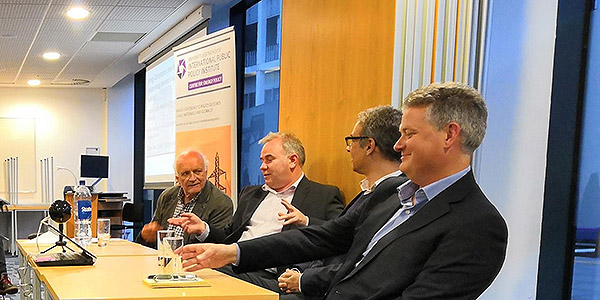
On Thursday 4 October the Centre for Energy Policy held an Energy Conversation entitled "How Feasible is the Ambition to Dramatically Reduce Energy Demand in our Non-Domestic Buildings?", part of Climate Week 2018. With representatives from Zero Waste Scotland, arbnco, as well as academic expertise from Strathclyde on the panel, this proved to be a fascinating and thought-provoking event.
Read Centre for Energy Policy team's reflections on this event below.

Left to right: Alf Young, Visiting Professor, IPPI; Andrew Maw, Senior Building Surveyor and Commercial Energy Assessor, arbnco; Dr Daniel Costola, Lecturer, Mechanical & Aerospace Engineering; Stephen Boyle, Strategic Programme Manager, Zero Waste Scotland.
 |
Ragne Low Principal KE Fellow, Centre for Energy Policy ragne.low@strath.ac.uk |
Many barriers to non-domestic energy efficiency were cited, including lack of awareness and interest, the small size of energy bills relative to other business costs for many commercial organisations, and the risks associated with trying (or investing in) anything new. Energy Performance Certificates (EPCs) also got a good airing, with many people feeling they were poor at predicting actual energy use and actual energy savings. But people also felt that there is a lot that can be done to close the gap between EPCs and actual building performance profiles, and that intelligent data management and analysis can help.
The co-benefits of improving energy efficiency were cited and people felt that these should be more prominent in discussions about energy efficiency – in particular how indoor air quality and comfort can be improved for workers. There was some debate about the right balance between carrots and sticks, with some calling for Government to use differential business rates to target energy efficiency and others arguing that we need to make the case for energy efficiency better and provide better support.
Energy performance contacting and energy-as-a-service were generally agreed to be positive things, with real potential to share the financial benefits of energy efficiency between performance contract providers and businesses that don’t have the time or resource to spend managing energy more efficiently, whilst also bringing down energy use and ultimately emissions. The importance of intelligent use of data was emphasised by many people.
 |
Dr Christian Calvillo Research Associate, Centre for Energy Policy christian.calvillo@strath.ac.uk |
Non-residential buildings are, in principle, the easiest target for energy efficiency intervention. You have to deal with less people (one or a small group of companies instead of lots of households) and they are cost conscious, so it should be straightforward, right? Well, unfortunately is not.
For some companies, energy bills are not really a concern. In many cases the owner of the building is a third party with little interest of investing on energy efficiency, and last but not least, employees might not care too much to play their part in being more efficient. When conventional ‘sticks and carrots’ don’t work, we need to think on new ways to incentivise this. Maybe some sort of ‘green certificate’ that helps improving the brand?
 |
Dr Oluwafisayo Alabi Research Associate, Centre for Energy Policy oluwafisayo.alabi@strath.ac.uk |
The route map for an energy efficient Scotland makes a compelling case for changes in the energy demand patterns of the non-domestic sector. However, there is a need to take a step back to assess and reflect on how responsive non-domestic building owners and occupiers are, to the current energy efficiency measures in place.
More attention needs to be directed at finding ways that make the energy efficiency objective simple and relatable to incentivise significant reduction of energy demand in non-domestic buildings. This may be achieved by implementing energy efficiency measures that are more people-centred rather than technology-centred.
 |
Dr Antonios Katris |
A key point raised in during the conversation was that energy use targets are usually linked to actual energy use, while at the same time policies often rely on EPCs to deliver the desired results. The problem is that actual energy use and EPC rating do not necessarily match. Indeed, there can be significant discrepancy between the potential (EPC estimated) and actual energy use of a building. And this often comes down to the knowledge/willingness to act of the person designated to monitor and control the energy use of the building.
Our next Energy Conversation, How feasible and desirable is a hydrogen future, takes place on Tuesday 27 November. Find out more and register here.
Tags: Energy